Did you know there are over 70 different types of snake plants, each with unique shapes, sizes, and patterns?
Snake Plants (Sansevieria) are among the most popular houseplants, prized for their air-purifying qualities, low maintenance, and striking appearance. With their ability to thrive in various conditions, they make the perfect addition to any home or office.
If you’re a beginner, knowing the different types of Snake Plants can help you choose one that fits your lifestyle and space. If you’re an experienced plant collector, discovering unique varieties can add excitement to your collection.
In this blog, we will explore 45 stunning types of snake plants with pictures and names. Whether you’re looking for a small tabletop plant or a tall statement piece, there’s a perfect Snake Plant waiting for you.
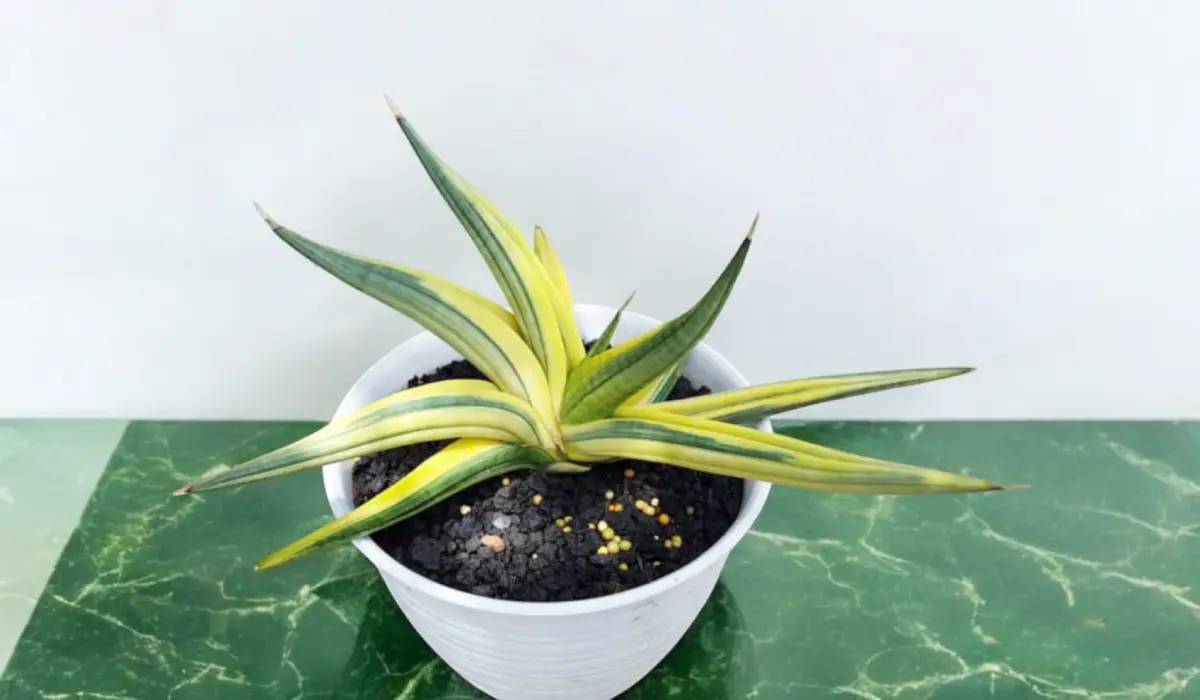
The world of snake plants is vast, with different types of snake plants offering unique characteristics to suit various preferences. Among them, the Dracaena patens stands out for its unconventional charm. Perfect for those who appreciate a more organic growth habit, this plant thrives in bright, indirect sunlight and adds a touch of wild elegance to any space.
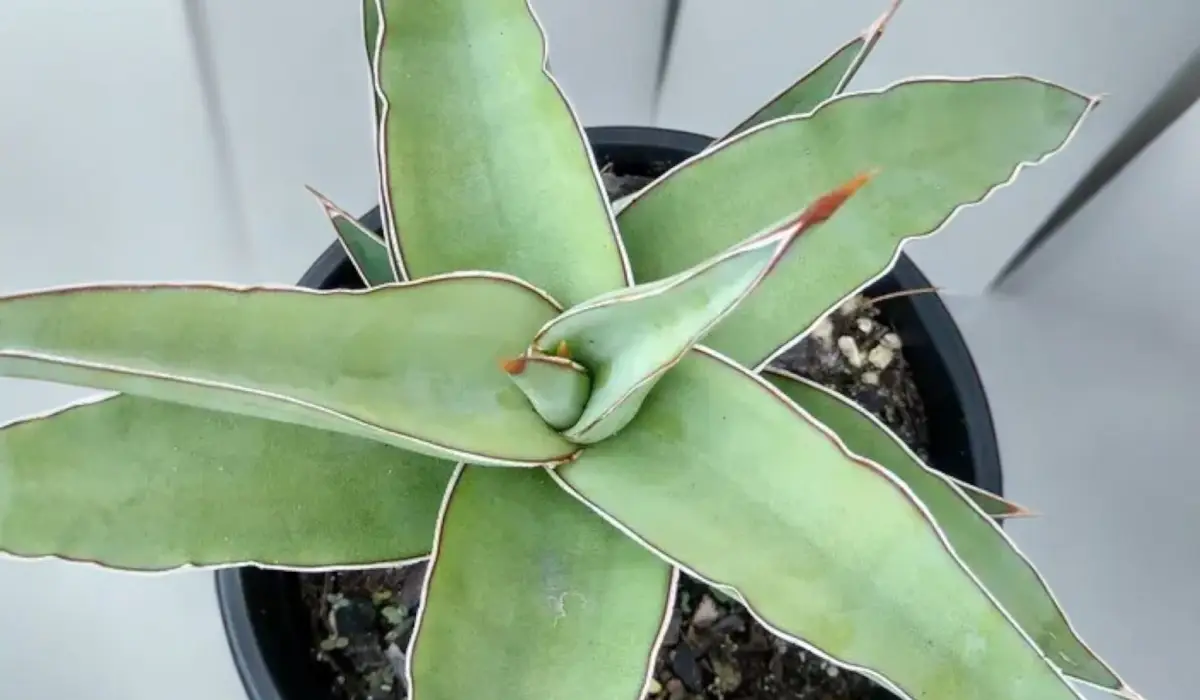
The Sansevieria Blue Kew, also known as Sansevieria Powysii ‘Blue Kew,’ is a stunning and resilient addition to any plant collection. Native to Africa, this slow-growing variety is celebrated for its arching blue-gray leaves that gracefully turn downward and fan out. The crinkled edges of its thick leaves are accentuated by a distinctive light bronze band along the margins. Known for its durability and air-purifying qualities—even praised by NASA.

The Sansevieria ‘Emerald Star’ is a stunning snake plant variety that combines beauty with practicality. It’s a compact yet eye-catching addition to any space. Originating from West Africa, the ‘Emerald Star’ is not only easy to care for but also excels at purifying the air, making it a perfect choice for homes or offices. Its ability to thrive in a range of light conditions—from low light to bright indirect light—adds to its versatility and appeal.
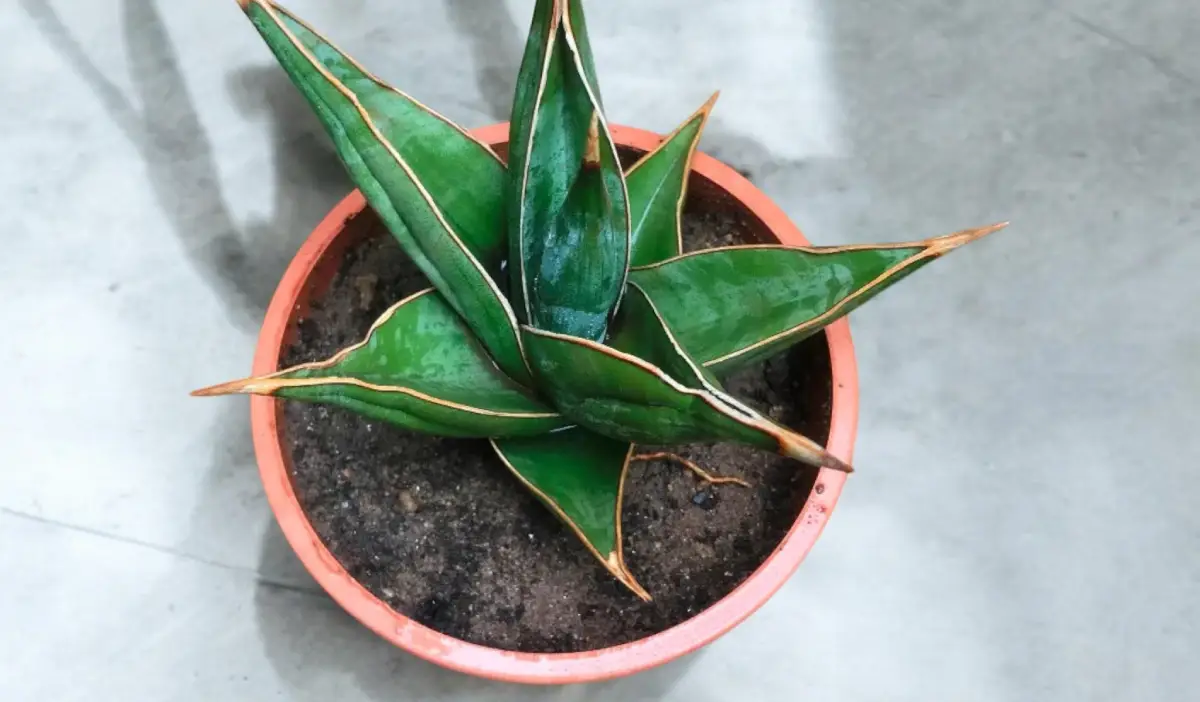
Commonly called the walking sansevieria, it is a fascinating and unique addition to the world of snake plants. Native to the Bura region of Kenya, this xerophytic succulent is known for its unusual growth habit: instead of spreading through underground rhizomes, it produces aerial stolons that develop into new plantlets. These plantlets send down stilt-like roots, giving the appearance that the plant is “walking” away from its parent.

The Sansevieria Rorida is a truly unique and eye-catching variety, formerly known as Lavranos 23319, and native to Somalia. Its bluish-toned leaves set it apart, and its growth habit is particularly unusual—offsets and leaf propagations produce small plants with fan-shaped leaves, unlike the typical rosette-forming leaves seen in most snake plants. While Sansevieria is known for tolerating low light, this variety’s leaf colors become more vibrant in brighter conditions. However, too much direct sunlight can cause browning at the edges.
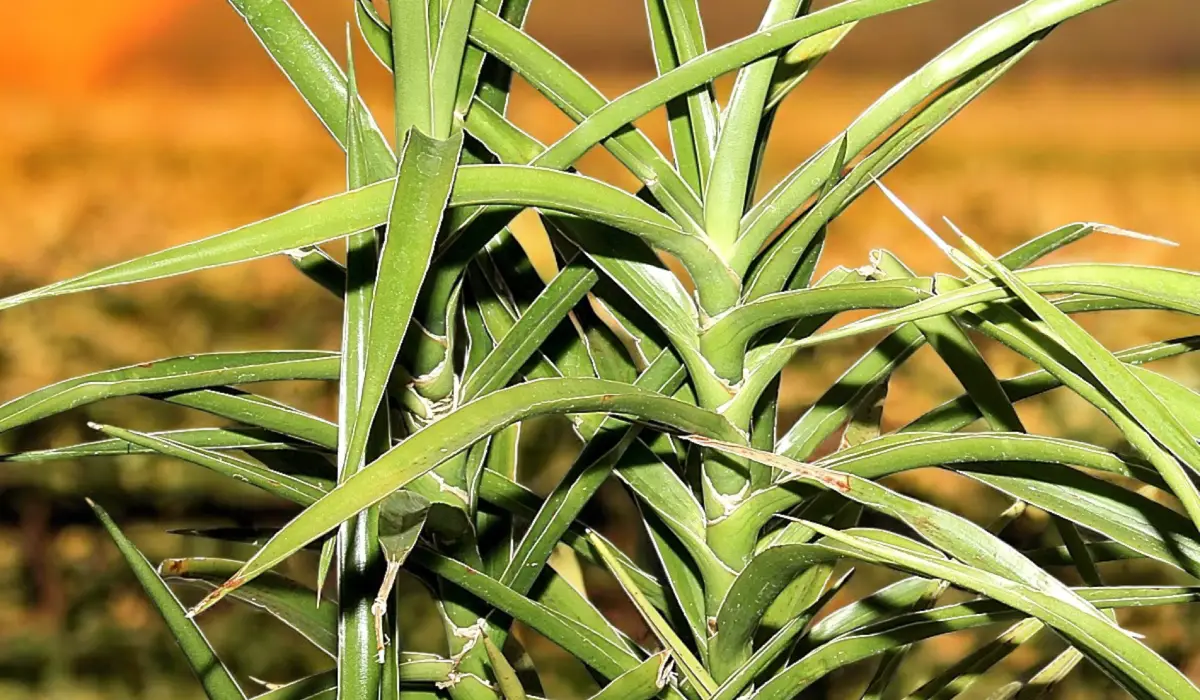
Native to Kenya and Tanzania, this plant features green leaves with a subtle coppery hue, arranged in a distinctive pattern that sets it apart from other snake plants. While it shares the hardy, low-maintenance qualities of other snake plants, its unusual coloration and impressive size make it a standout choice for plant enthusiasts.
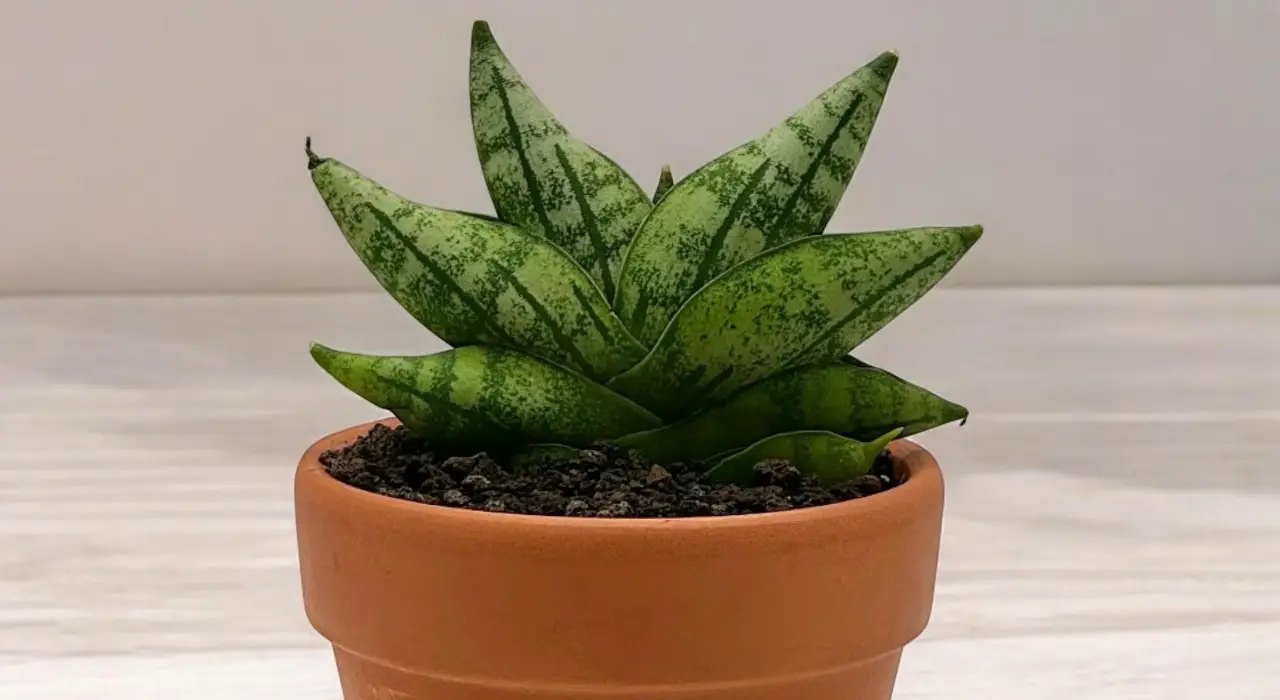
The Sansevieria ‘Dwarf Boncel’ is a rare and captivating variety, perfect for those who adore compact and unique plants. Its small size makes it an ideal choice for small spaces like window sills. Its round, stout leaves fan out like little fingers, showcasing vibrant light green hues with striking dark green concentric circles running from top to bottom. Adaptable to various light conditions, from full sun to indirect light, this low-maintenance succulent thrives with minimal care—water only when the soil is dry.
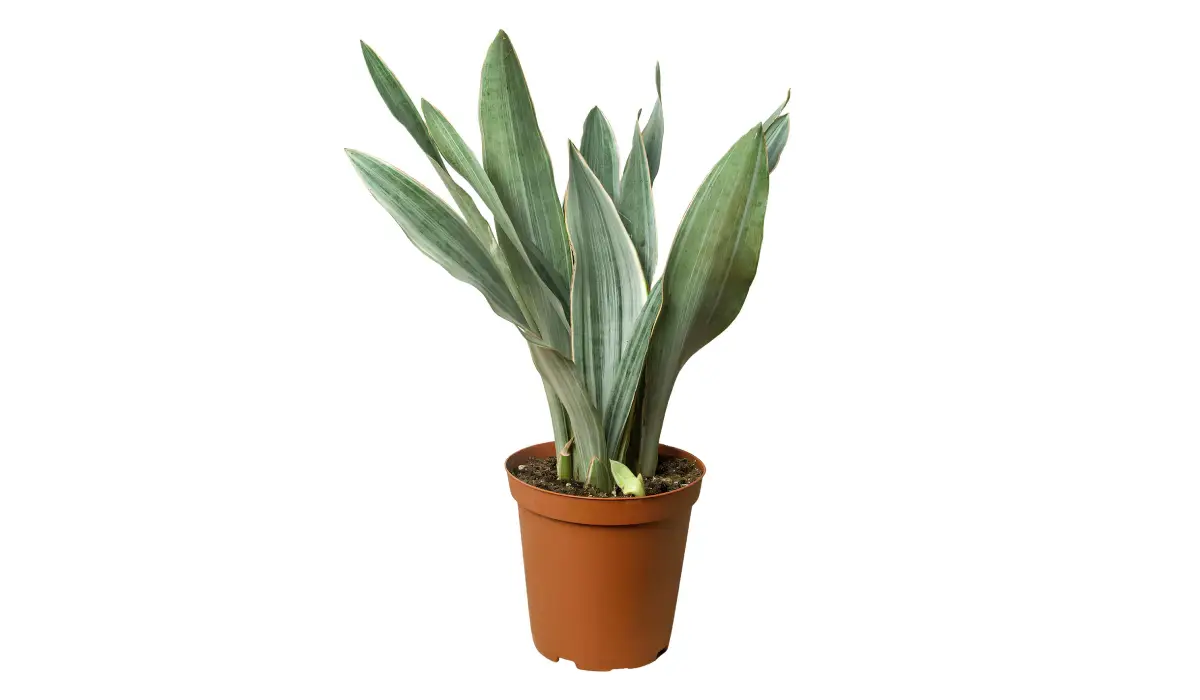
The Sansevieria ‘Sayuri’ is a standout cultivar that brings a touch of sophistication to the world of snake plants. Native to West Africa, this variety is celebrated for its hardiness, air-purifying qualities, and striking appearance. Its vibrant green leaves are adorned with bold, irregular creamy white stripes that run vertically, creating a dramatic, graphic look. The ‘Sayuri’ is both elegant and easy to care for, thriving in low light, dry air, and with infrequent watering. Perfect for beginners or busy plant lovers, it’s a low-maintenance gem that adds a modern flair to any space.
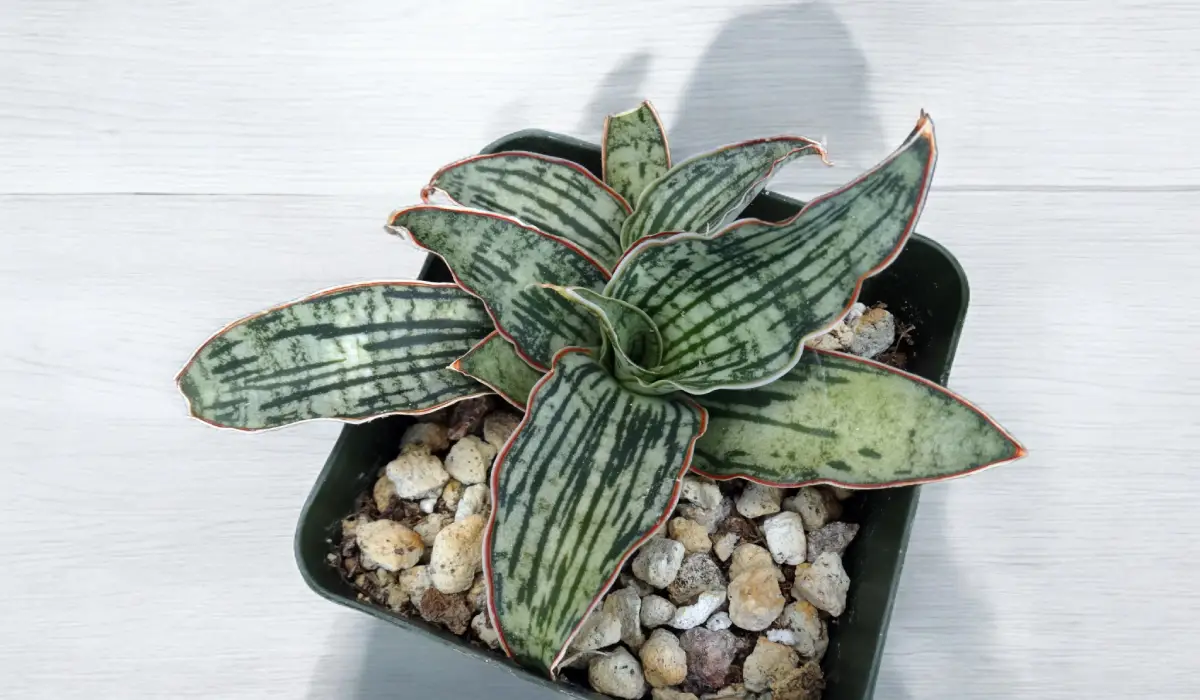
This unique type of snake plant is a hybrid variety that brings a touch of elegance to the diverse world of snake plants. Originating from Indonesia, this compact plant reaches a height of 12-14 inches and is celebrated for its eye-catching light green leaves adorned with intricate dark green patterns. Its rosette-shaped growth adds a soft, architectural appeal, making it a favorite for those who appreciate both beauty and practicality. Perfect for tabletops or small spaces.

The Sansevieria ‘Star Rose’ is a collectible succulent that brings both beauty and resilience to any indoor space. Belonging to the Asparagaceae family, this small to medium-sized plant grows slowly. Its rosette-shaped growth features fleshy, wide, and thin leaves. The olive green leaves are accentuated by irregular beige tips or edges, adding a touch of elegance. Ideal for well-lit areas, it thrives in indirect light and should be protected from direct sun and frost.
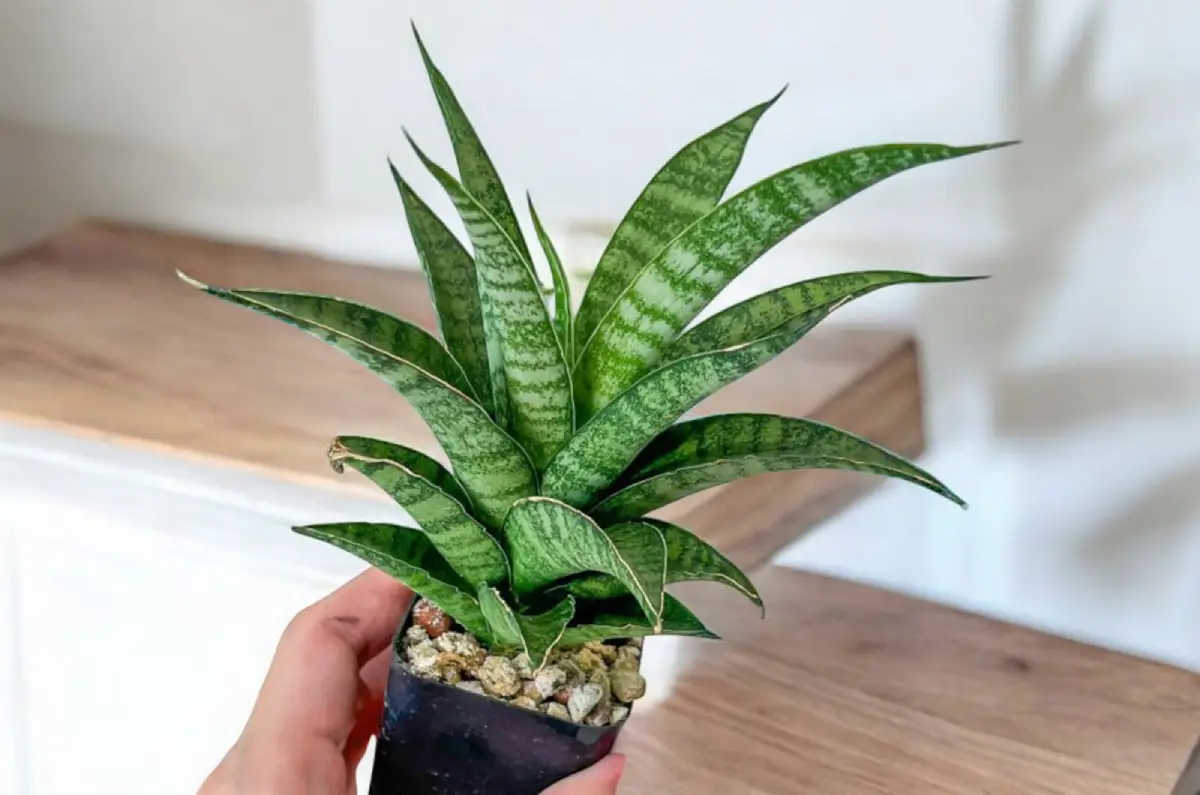
A fascinating new hybrid from Indonesia is believed to be a cross between S. Cylindrica and S. Ballyi. This unique variety is grown with care and propagated naturally from the mother plant without the use of fertilizers, sprays, or brighteners. Its slow-growing nature and striking appearance make it a standout addition to any indoor plant collection. The ‘Crocodile Rock’ thrives in sunny to semi-shady locations, with brighter light enhancing its contrasting stripe patterns. Potted in a self-mixed, permeable organic substrate, it requires minimal repotting and is easy to care for, as long as waterlogging is avoided.
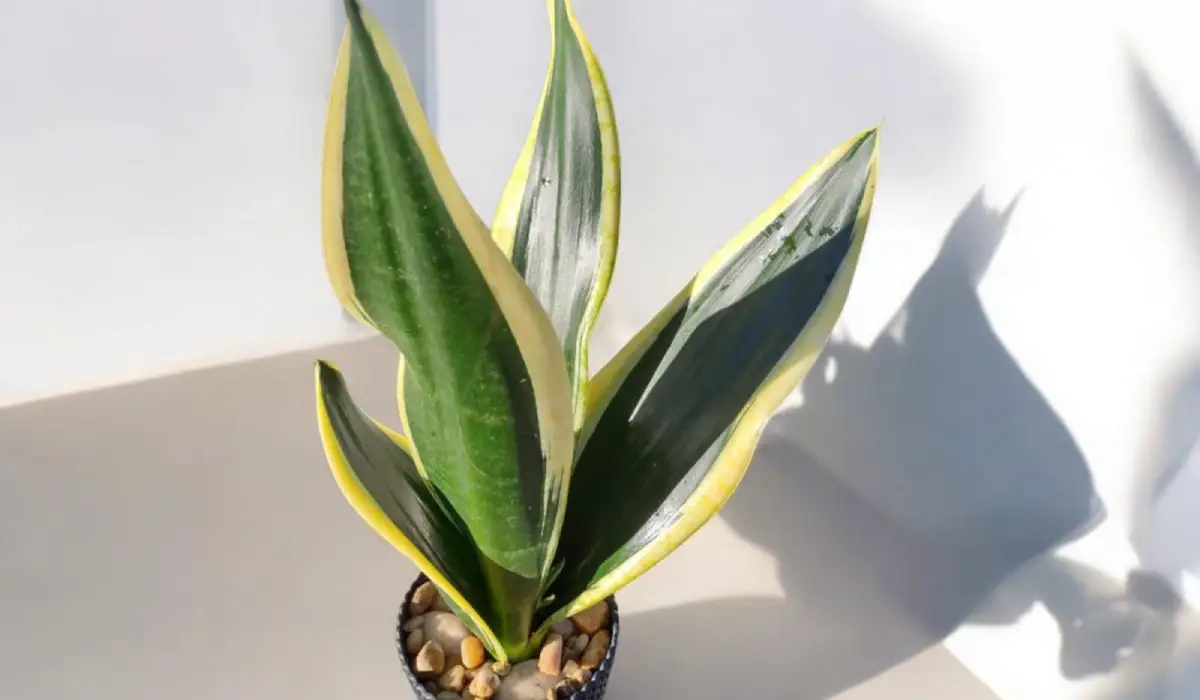
A standout among the types of snake plants, Sansevieria ‘Black Gold’ captivates with its deep green leaves elegantly bordered in vibrant yellow. This striking contrast makes it a popular choice for both modern and traditional indoor settings. Its sword-shaped foliage not only enhances décor but is also believed to bring positive energy.

Among all types of snake plants, this fan-shaped snake plant grows tubular spikes from a central point, giving it a distinct and structured look. Native to Angola, it thrives in bright sun, warm temperatures, and low humidity. While it performs best in bright light, it is also highly adaptable to low-light conditions.
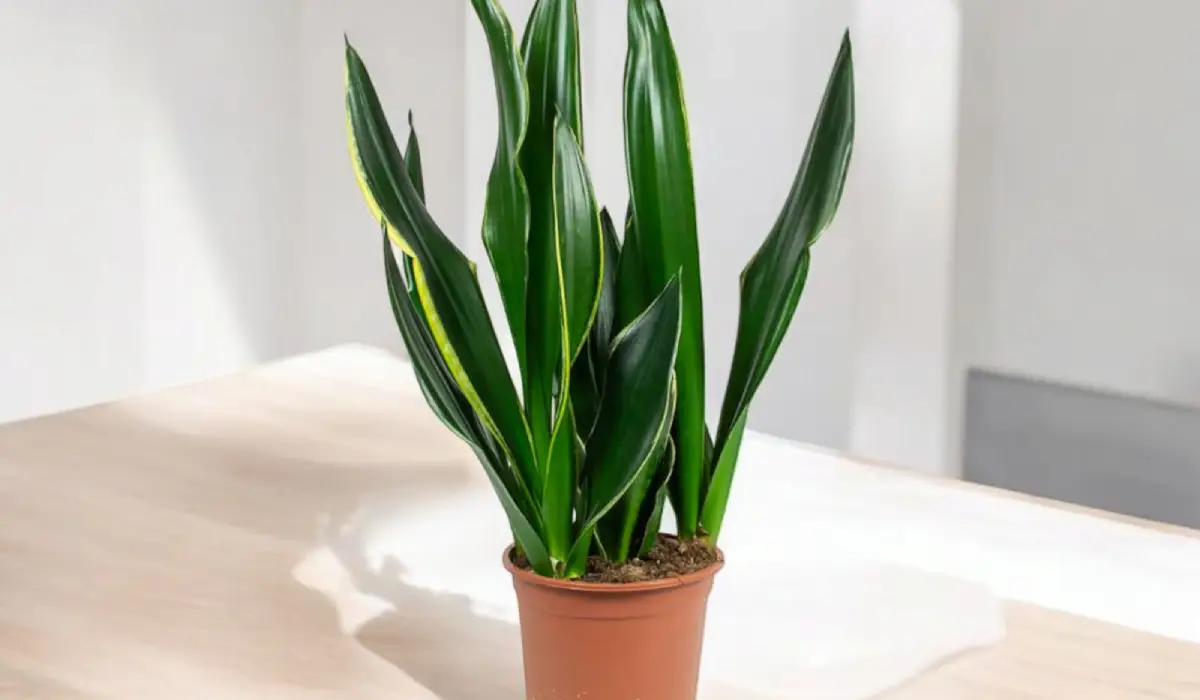
This type of snake plant is a striking and resilient addition to any plant collection, known for its bold, architectural presence. This variety features broad, diamond-shaped dark green leaves, often edged with a narrow band of golden yellow, creating a glossy, deep green statement. Native to tropical West Africa, from Nigeria to the Congo, the ‘Diamond Flame’ thrives in a variety of conditions, making it a perfect choice for both beginners and seasoned plant enthusiasts.
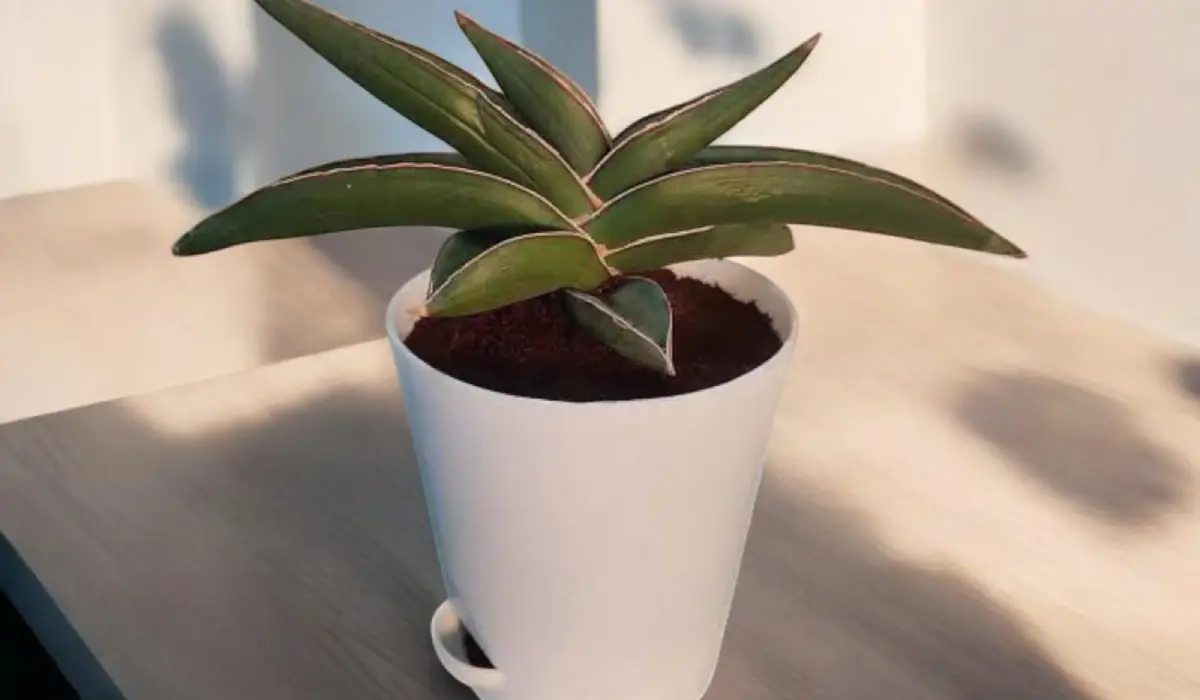
The Sansevieria ehrenbergii, often referred to as the sword sansevieria or blue sansevieria. Known for its thick, fibrous leaves with a striking blueish tone, this species features pointed foliage that fans out in an attractive, architectural manner. While it is one of the larger snake plant varieties, it grows slowly, taking many years to reach its full mature size.
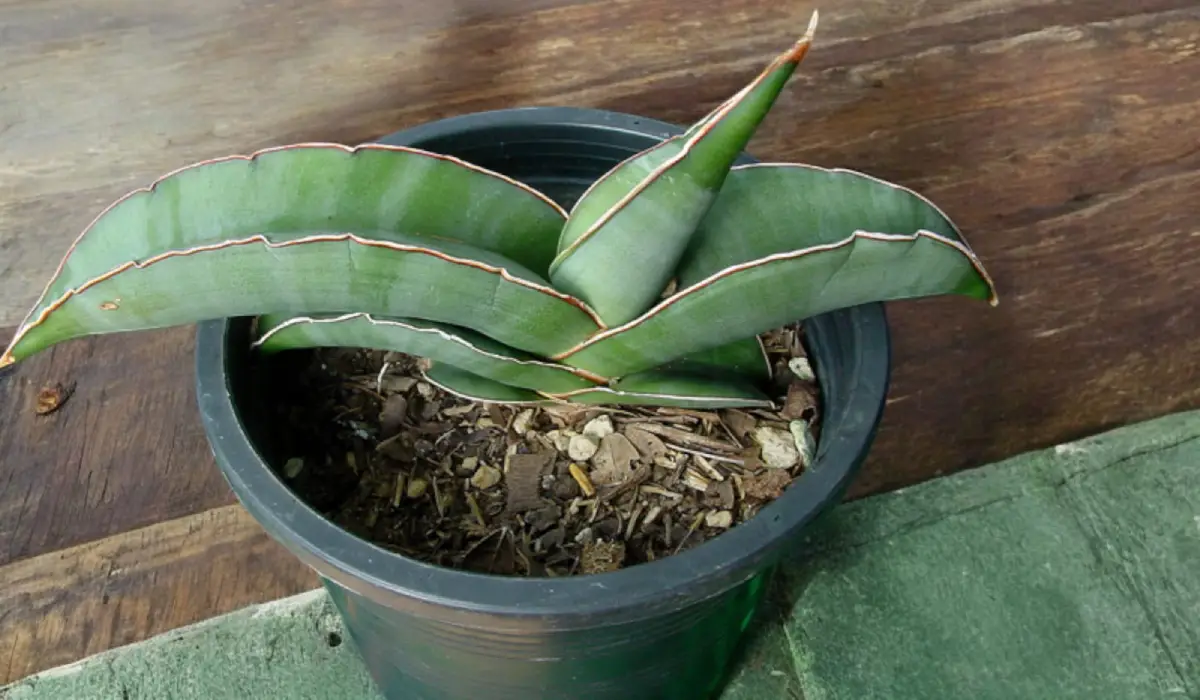
The Sansevieria ehrenbergii ‘Banana’ is a fascinating dwarf variety that adds a unique touch to the diverse family of snake plants. Hailing from Somalia, this compact plant earns its name from its distinctive banana-shaped leaves, which become thick, boat-like, and deeply channeled as they mature. Its curved, gray-green to blue-green foliage creates a striking visual appeal. Ideal for small spaces or as a desktop companion, and easy to care for.
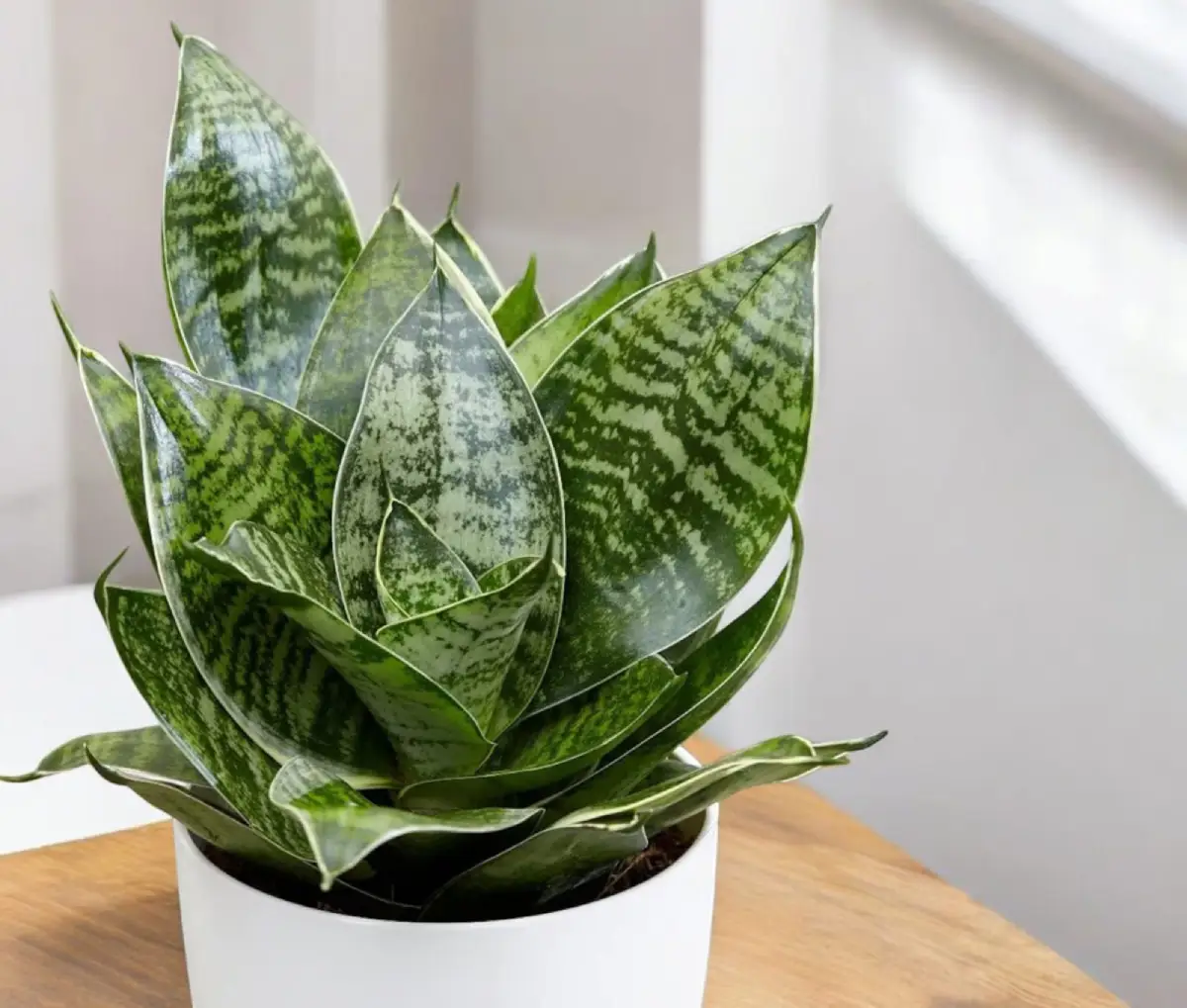
When you think of compact snake plants, Sansevieria trifasciata ‘Hahnii’ is a standout choice. Often called the Bird’s Nest Snake Plant, this charming, low-growing succulent forms elegant, funnel-shaped rosettes that add a sculptural touch to any space. Its whitish-green leaves, irregularly mottled with darker green, create a beautifully variegated effect, making it a favorite among plant lovers.
While Sansevieria trifasciata ‘Hahnii’ can bloom in summer or fall, this cultivar rarely flowers. When it does, it produces sweetly scented, greenish-white blooms on upright stalks.
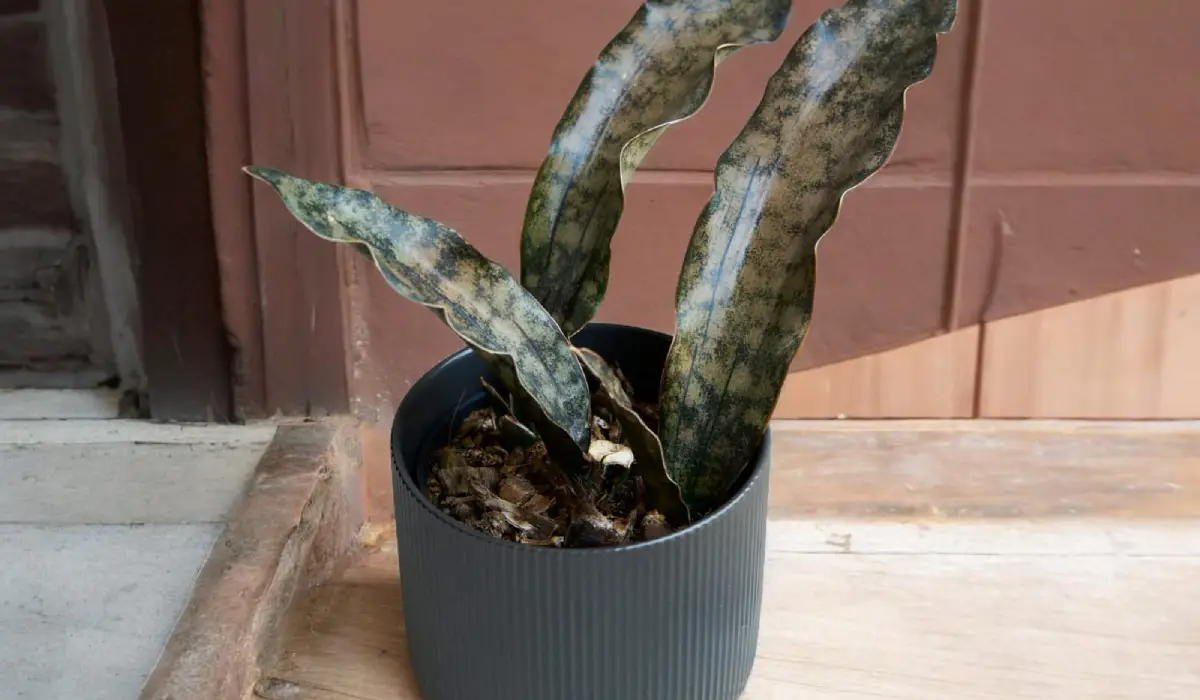
Easily recognized for its long, slender leaves with a rich bronze or brown hue. Unlike the Silver Blue variety, its mature leaves retain their distinctive coloring, though they may fade slightly over time. The newest growth often emerges with an orange tint before deepening into its signature tone.
From a distance, the plant’s warm, coppery tones set it apart from other snake plants. Native to Zanzibar in Tropical East Africa, this semi-succulent species is both striking and resilient, making it a standout addition to any indoor plant collection.

When you think of unique snake plants, the Sansevieria kirkii ‘Silver Blue’ stands out for its distinctive thick, oval-shaped leaves with a subtle blue sheen. This striking hue is most prominent on new leaves under a year old, gradually fading as the leaf matures. The plant’s thick leaves are edged with a narrow red border and feature the classic snake plant mottled pattern, enhanced by darker longitudinal lines that add depth and visual interest.
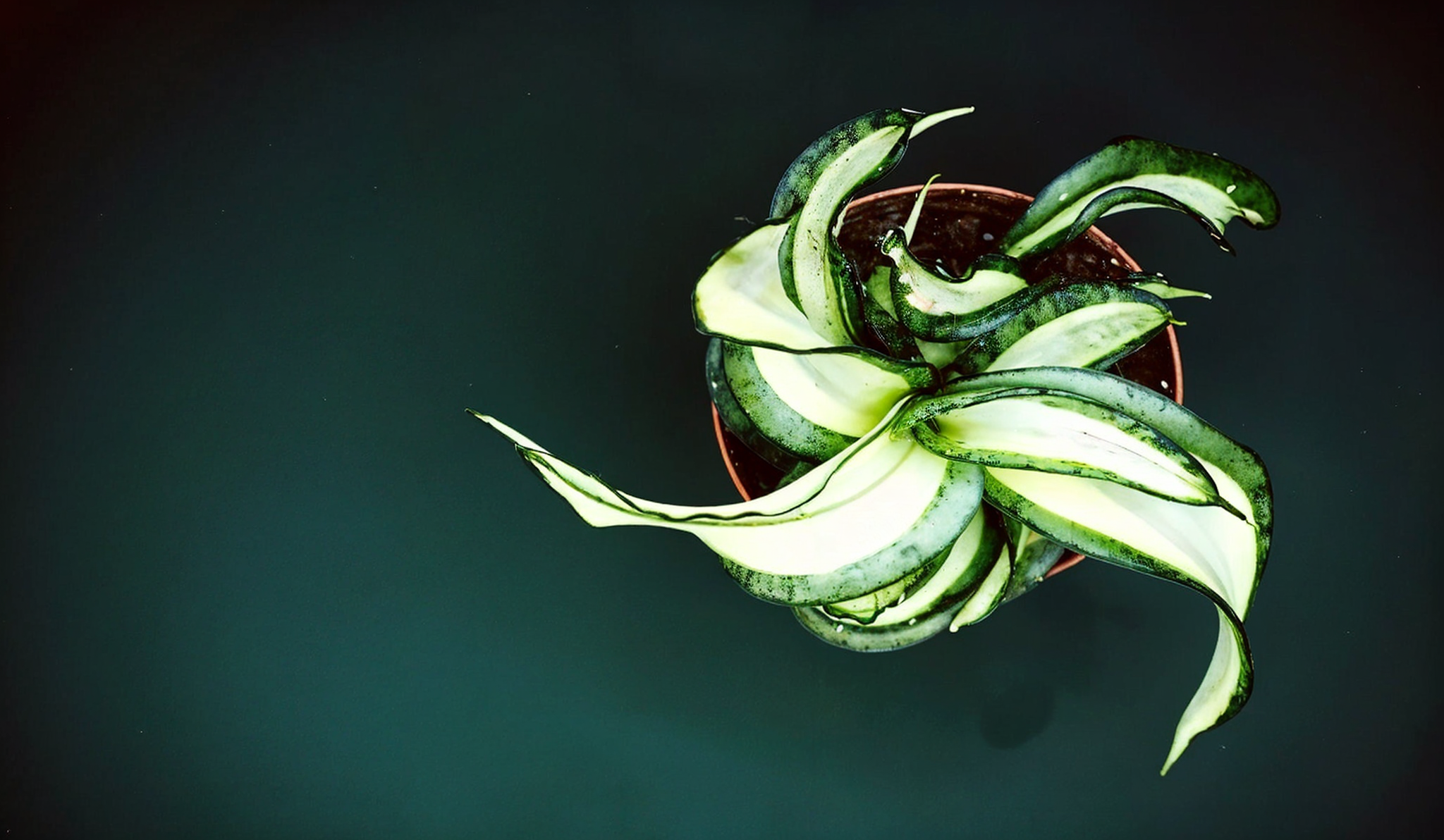
The Sansevieria ‘Golden Wendy’ is a stunning and compact variety. This stemless succulent features twisted yellow bands on its leaves, arranged in an attractive rosette pattern. It forms clusters of leafy funnels as it spreads, making it a charming and low-maintenance choice. Known for its resilience, this snake plant thrives in low light, requires minimal watering, and is highly resistant to pests. Plus, its air-purifying qualities, as recognized by NASA, help remove toxins like formaldehyde and benzene.
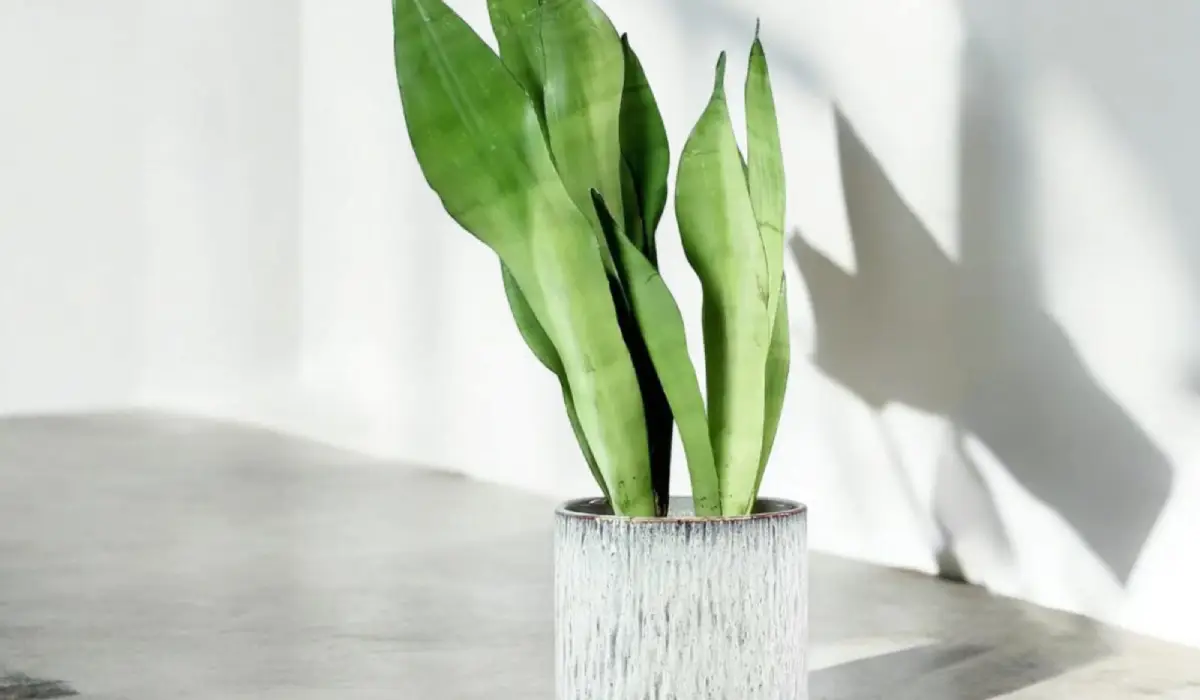
Sansevieria trifasciata ‘Moonshine’ is one of the most stunning varieties. Sometimes called the silver snake plant, this unique cultivar stands out with its pale silvery-green, spear-shaped foliage edged with darker green margins. New leaves emerge in an almost white shade before maturing to a soft silver-gray. While ‘Moonshine’ thrives in low light, its signature silvery tones are best preserved in bright, indirect light—darker conditions will cause the foliage to deepen in color.

This classic variety adds height and structure to any indoor space. It is popular for its incredibly easy-going nature (it can tolerate low light and drought) and its air-purifying capabilities. The easiest way to kill this plant is to overcare for it. Its sword-shaped foliage not only makes a statement but is also favored in feng shui for its ability to deflect negative energy.

Known for its gracefully arching leaves, this plant features a striking mix of lush green and creamy yellow stripes, creating a vibrant and eye-catching display. Originating from West Africa, it brings a touch of natural elegance to any space, whether placed alone as a focal point or grouped with other plants. Its compact size and architectural form make it versatile for tabletops, shelves, or corners.
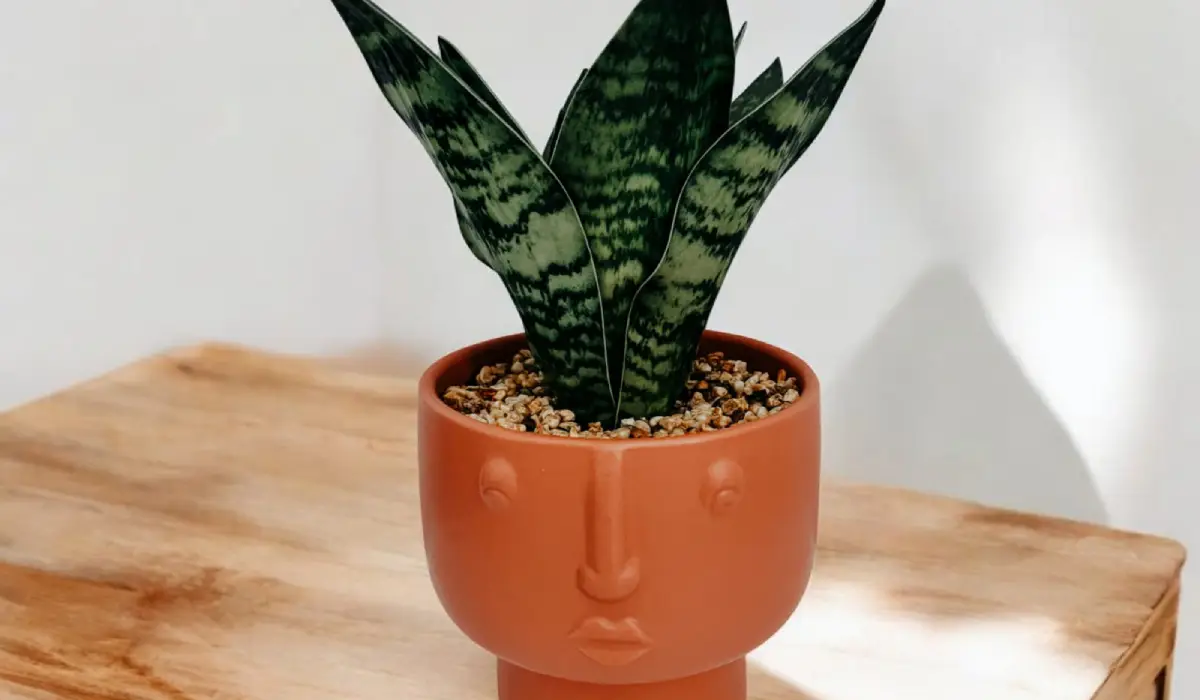
The Sansevieria trifasciata ‘Robusta’ is a striking and resilient plant that effortlessly combines strength with elegance. This variety features bold, dark green leaves adorned with lighter, striated patterns, creating a textured and visually dynamic appearance. Its upright, architectural growth habit makes it a standout in any interior setting. Known for its adaptability, ‘Robusta’ thrives in a range of conditions with minimal care, making it a favorite for both novice and experienced plant enthusiasts.
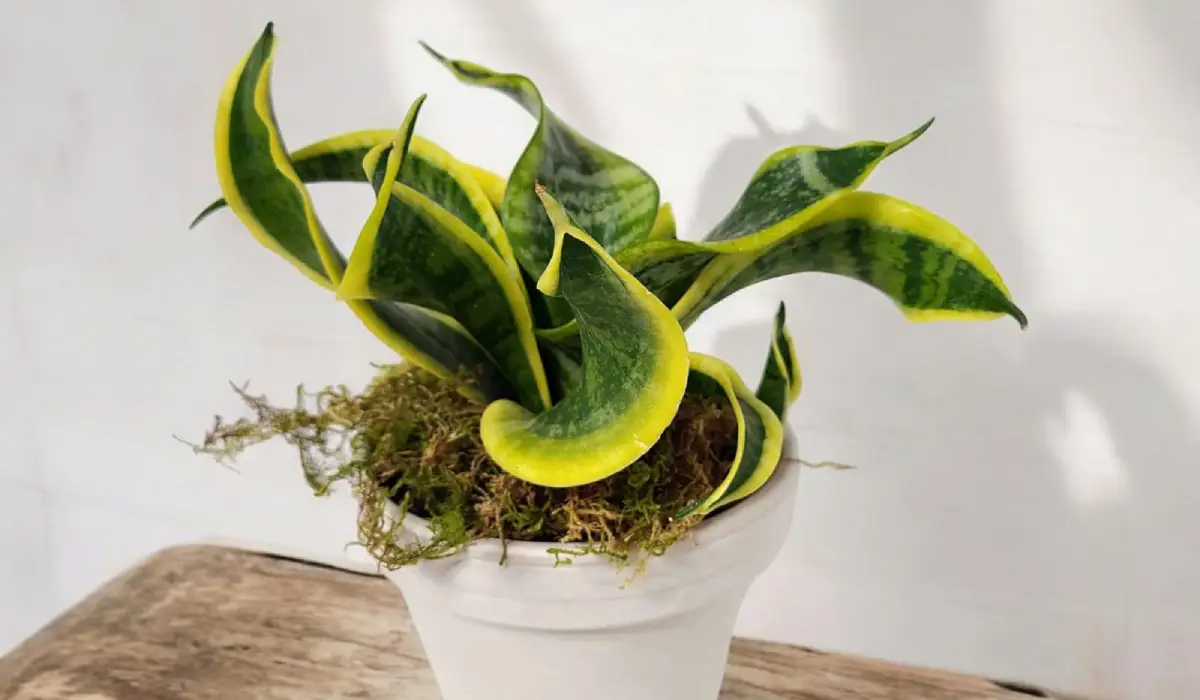
Sansevieria trifasciata ‘Twisted Sister’ is a unique dwarf variety known for its distinctive twisted leaves. With its vibrant green and yellow variegation, this compact plant creates a bold statement in any indoor space. The silvery green markings on its foliage add to its visual appeal, making it a favorite among houseplant enthusiasts. Its small size and striking form resemble a bird’s nest, adding texture and movement to a plant collection.
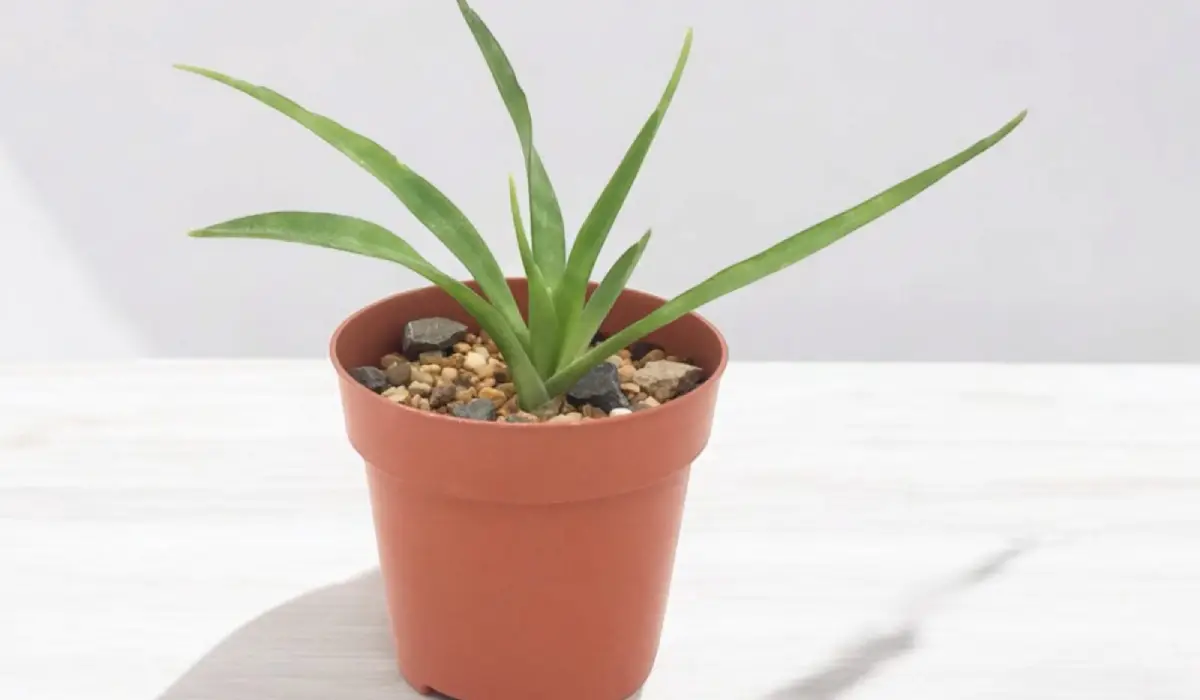
The Sansevieria ‘Parva,’ also called the Kenya Hyacinth, is a rare type of snake plant. When it flowers indoors, it produces pinkish-white blooms with a pleasant fragrance, which inspired its common name. Young plants display pale green horizontal bands, which mature to solid green over time. For an extra touch of uniqueness, keep an eye out for the variegated cultivar, which boasts striking yellow-white stripes along its leaves.
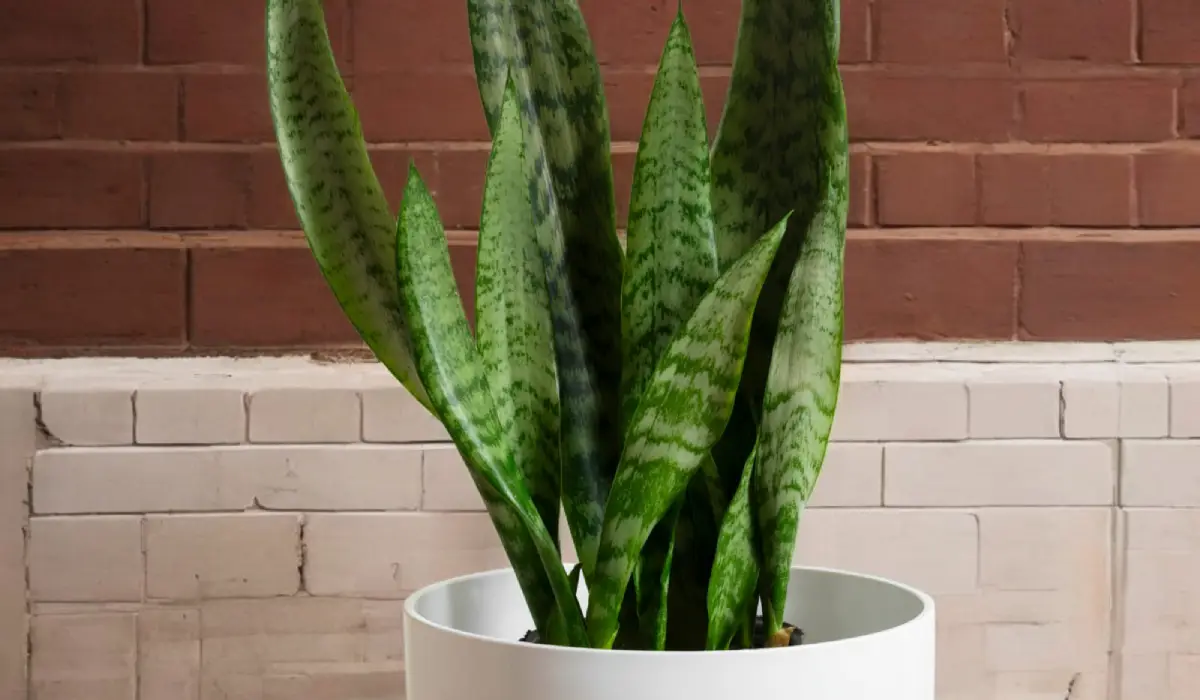
Often referred to as Devil’s Tongue, it is a captivating addition to the diverse family of snake plants. Known for its thick, upright leaves, this variety showcases a stunning combination of dark and light green markings, with an almost olive-toned base and twisty, horizontal light green stripes. It brings a bold, architectural presence to any space.
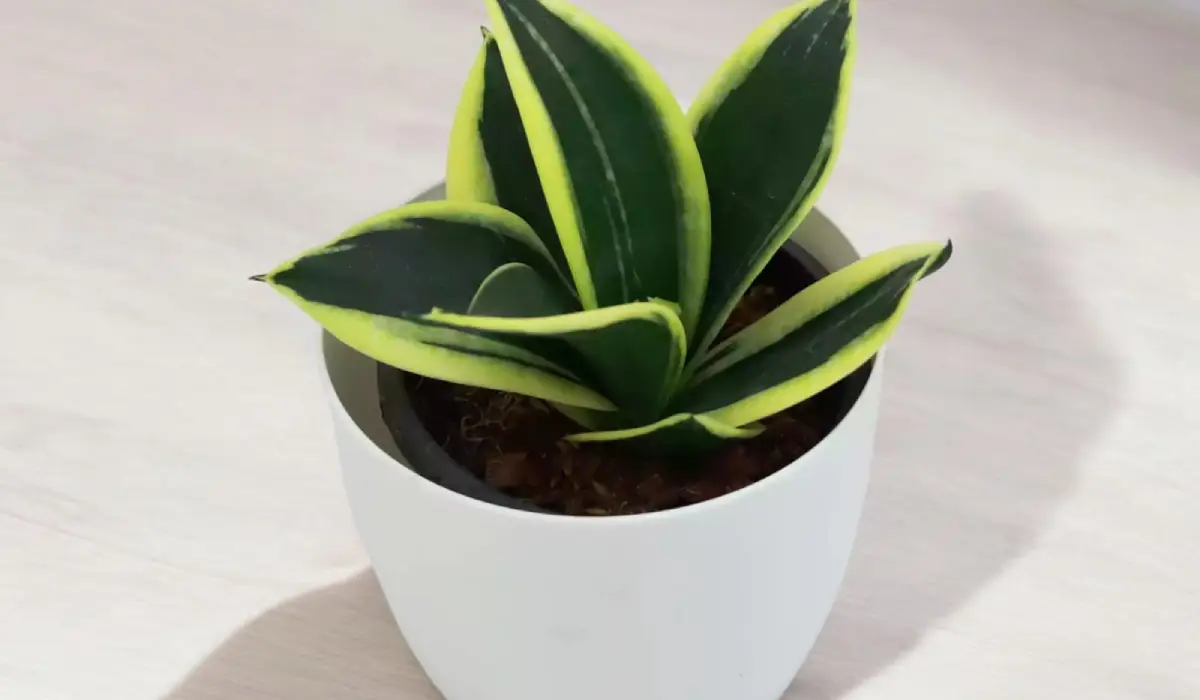
This eye-catching type of snake plant known for its compact, rosette-like growth, features lush, heart-shaped leaves that bring a touch of nature’s artistry indoors. Its manageable size and striking appearance make it a perfect addition to any room. Thriving in bright light and requiring only occasional watering, the Lotus Hahnii is ideal for those seeking a stylish yet hassle-free houseplant. While it grows slowly, its eventual full growth promises a stunning display of color and texture.
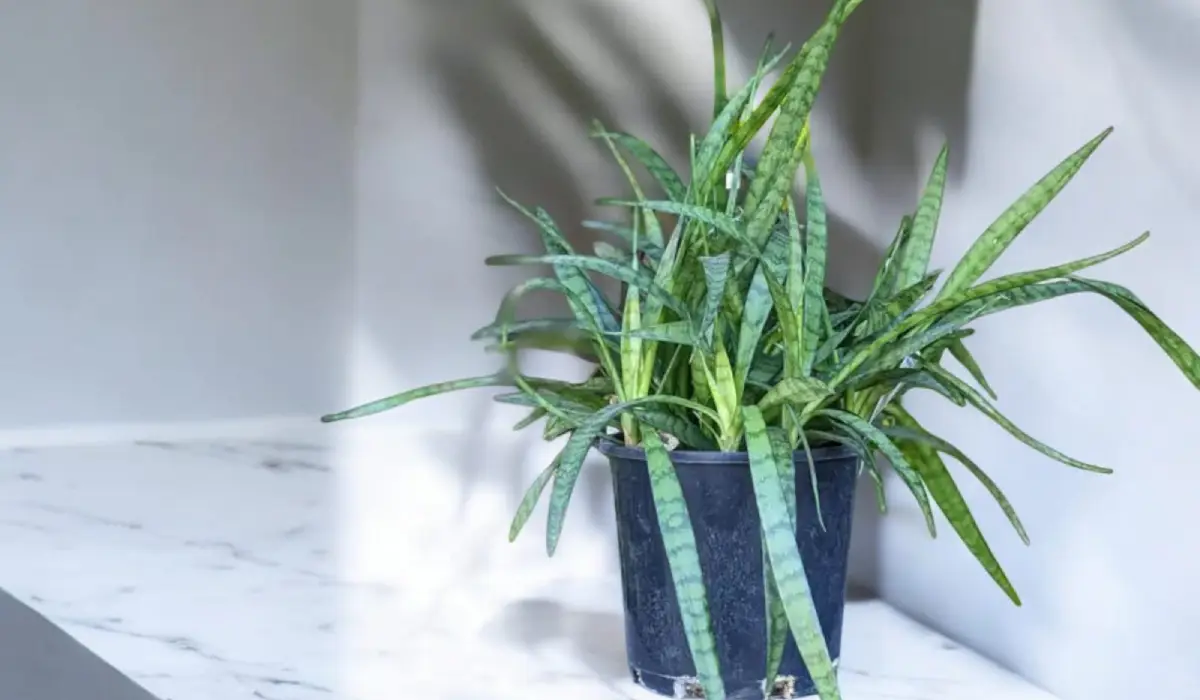
Sansevieria dooneri is a compact yet striking snake plant variety known for its rich green, sword-shaped leaves arranged in a tight rosette. The foliage features subtle variegation with faint horizontal bands, giving it a refined yet bold appearance. This resilient plant thrives in low-light conditions, making it an excellent choice for indoor settings. During the blooming season, it produces delicate, pale greenish-white flowers that emerge on a slender stalk, adding a rare floral charm to its robust structure.
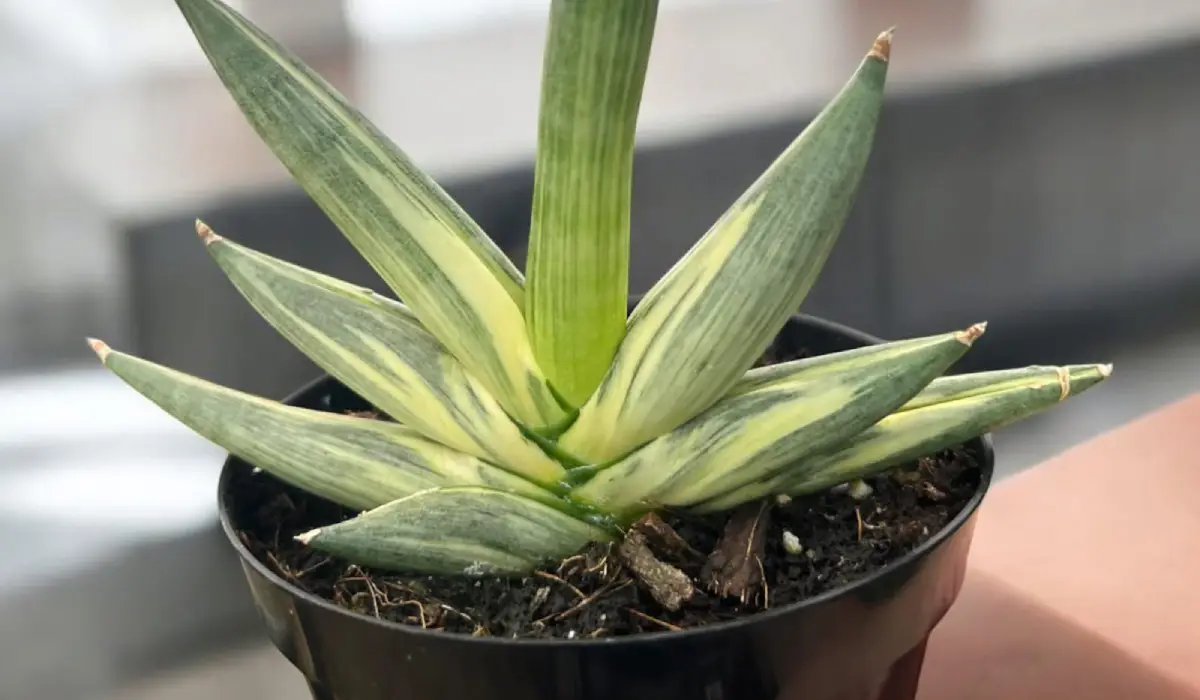
Sansevieria cylindrica ‘Boncel’, often referred to as the ‘Starfish’ sansevieria, is a standout variety known for its unique, finger-like leaves that radiate outward, resembling the shape of a starfish. This particular cultivar is especially prized for its variegation, a rare feature that adds to its visual appeal. The spiny leaves display a stunning combination of grayish-green with dark green variegation and subtle silver accents, maintaining their striking appearance year-round.
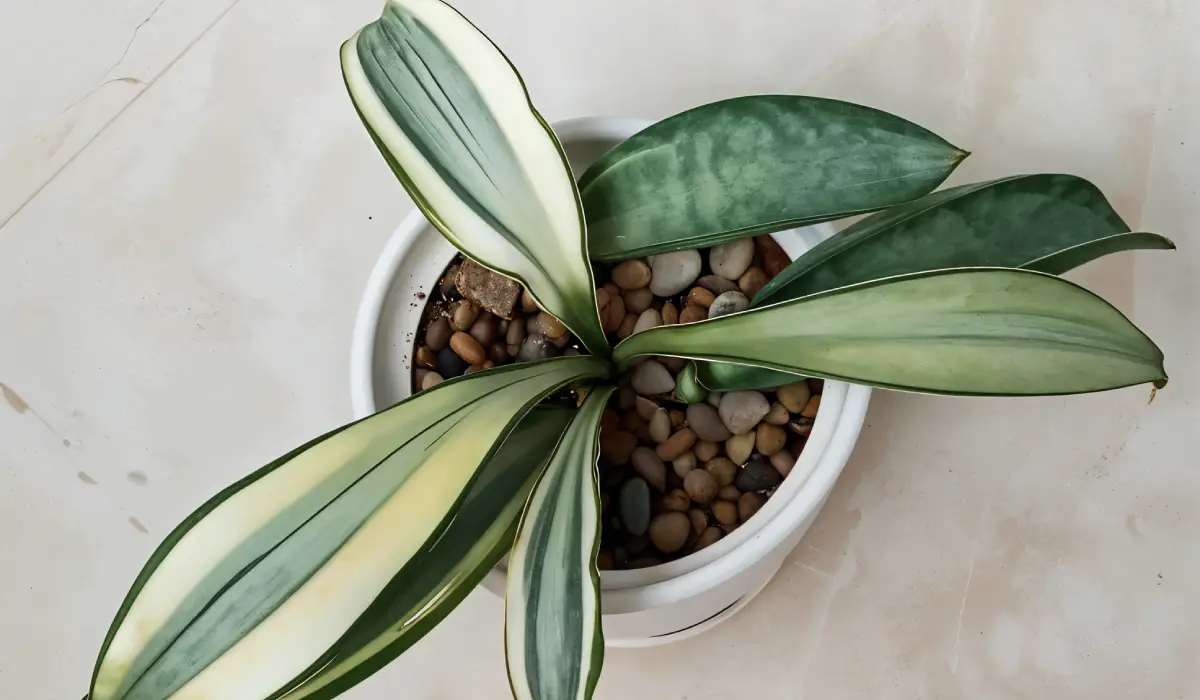
Sansevieria masoniana ‘White’ Variegated is a rare and stunning variety of the Whale Fin snake plant. Known for its broad, paddle-like leaves, this unique form features striking white variegation that remains vibrant for years without turning brown. In addition to its striking appearance, this hardy species thrives on minimal care, making it a perfect choice for forgetful plant owners. With proper care, its thick, long-lasting leaves can endure for a decade or more.
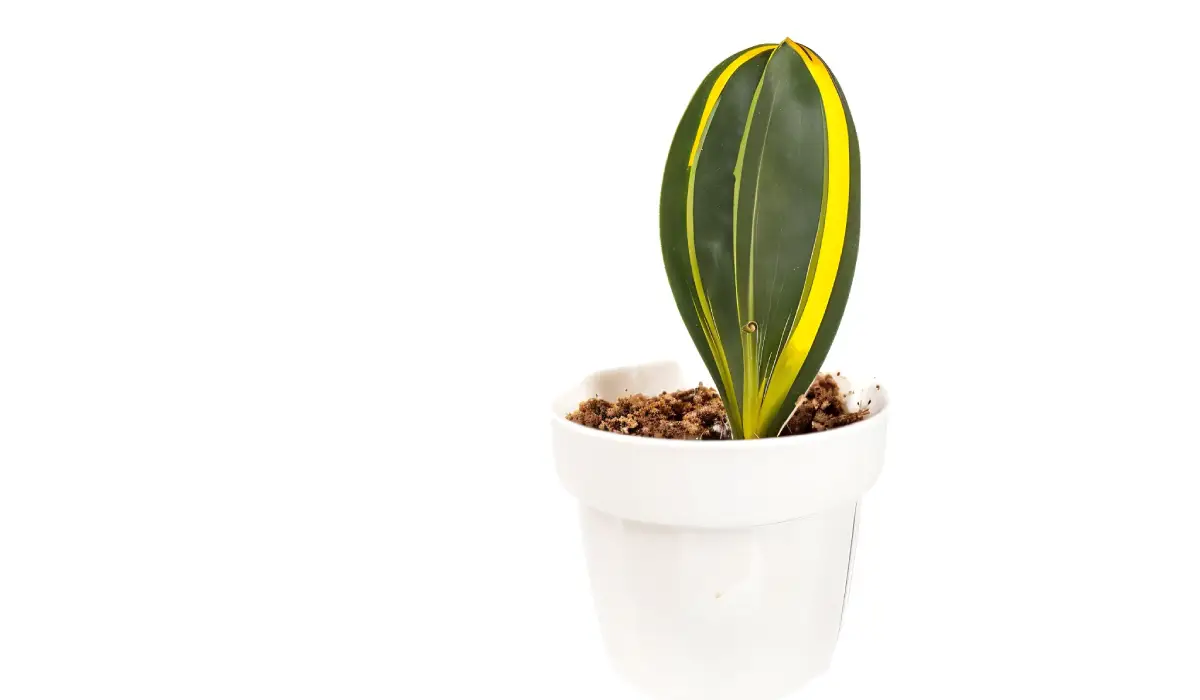
Sansevieria masoniana ‘Yellow’ Variegated is a striking and resilient variety of the Whale Fin snake plant, known for its broad, paddle-shaped leaves with vibrant yellow variegation along the edges. This unique coloration contrasts beautifully with the plant’s deep green, patterned foliage. Highly adaptable, it thrives in bright, indirect light but can also tolerate lower light conditions with ease.

Sansevieria masoniana ‘Whale Fin’ is a rare and striking variety of snake plant, easily recognized by its broad, paddle-like leaves that resemble the fin of a whale. This eye-catching species features dark green foliage adorned with light green spots and a unique splotchy pattern. Its bold appearance makes it a standout addition to any indoor plant collection.
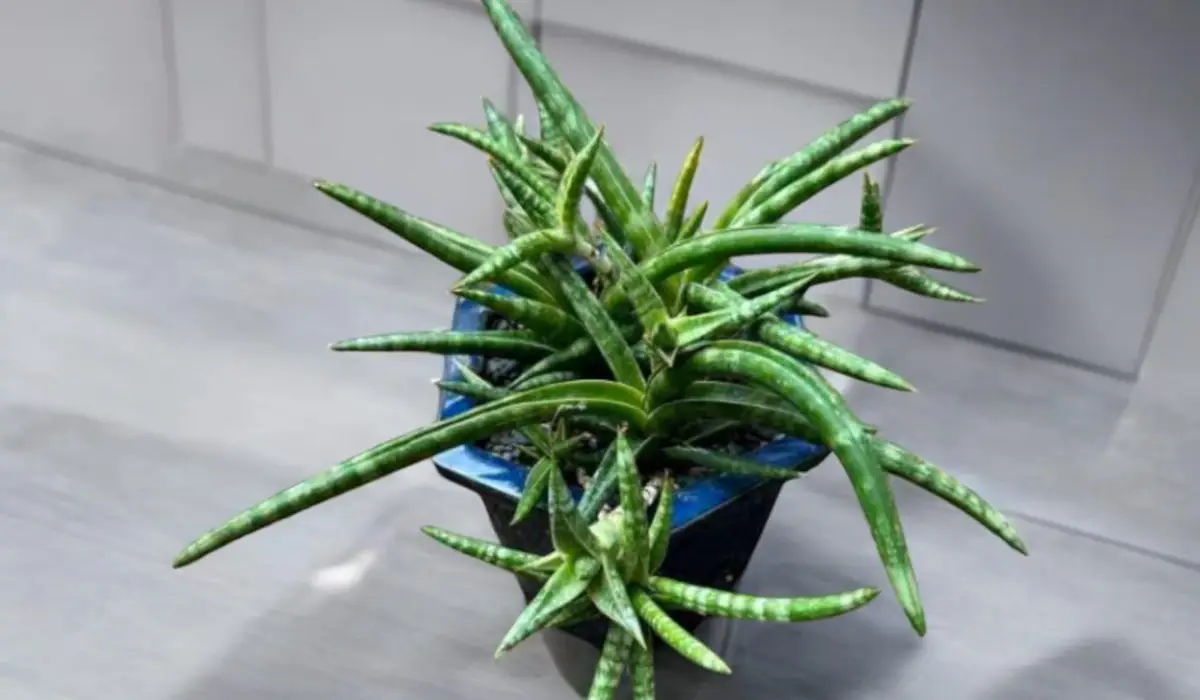
This variant of snake plant is a standout for its compact size and charming appearance. This dwarf variety features variegated, narrow leaves, making it an excellent choice for small spaces or as a tabletop plant. Occasionally, it blooms delicate white or pink flowers, adding a touch of elegance to its already appealing look. With its thin, tubular foliage and compact growth habit, it’s no wonder this plant is often called the dwarf snake plant.
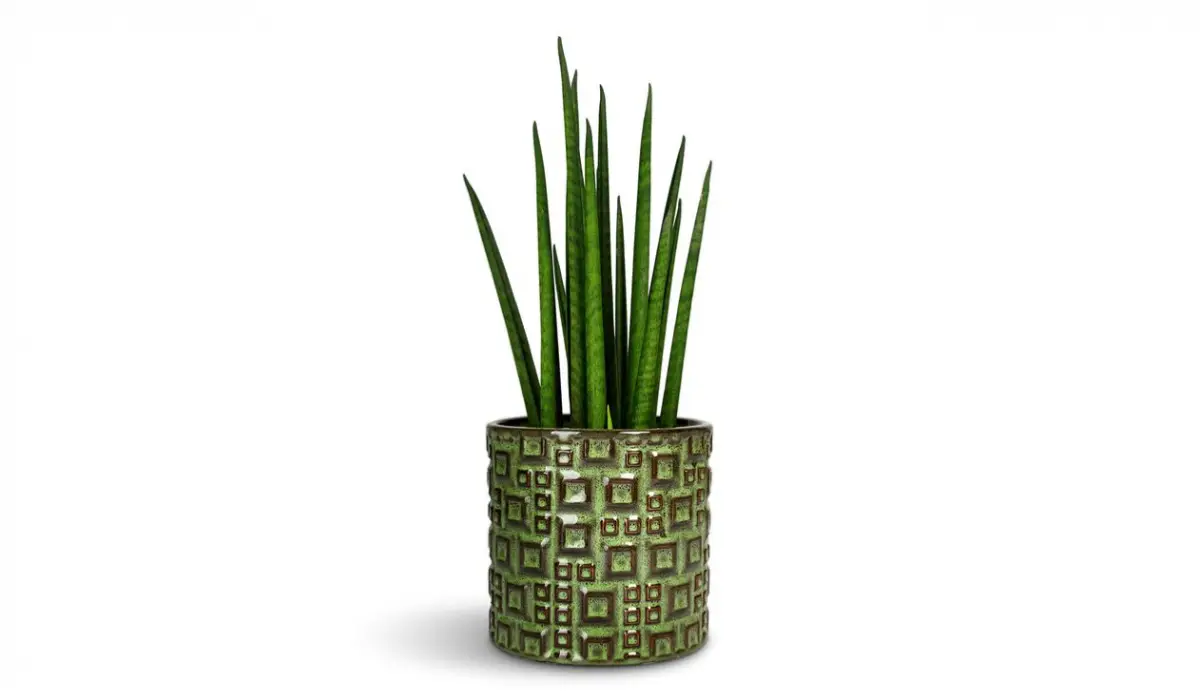
Native to the Congo and Rwanda, this member of the Asparagaceae family plant was first described in 2010 and has quickly gained popularity under names like Mikado, Fernwood, or Musica. Its stemless design features fleshy, elongated leaves that grow singly or in pairs from the rhizome. The dark green leaves are beautifully marked with horizontal light green stripes and a nearly black vertical furrow, adding a touch of sophistication to any space.
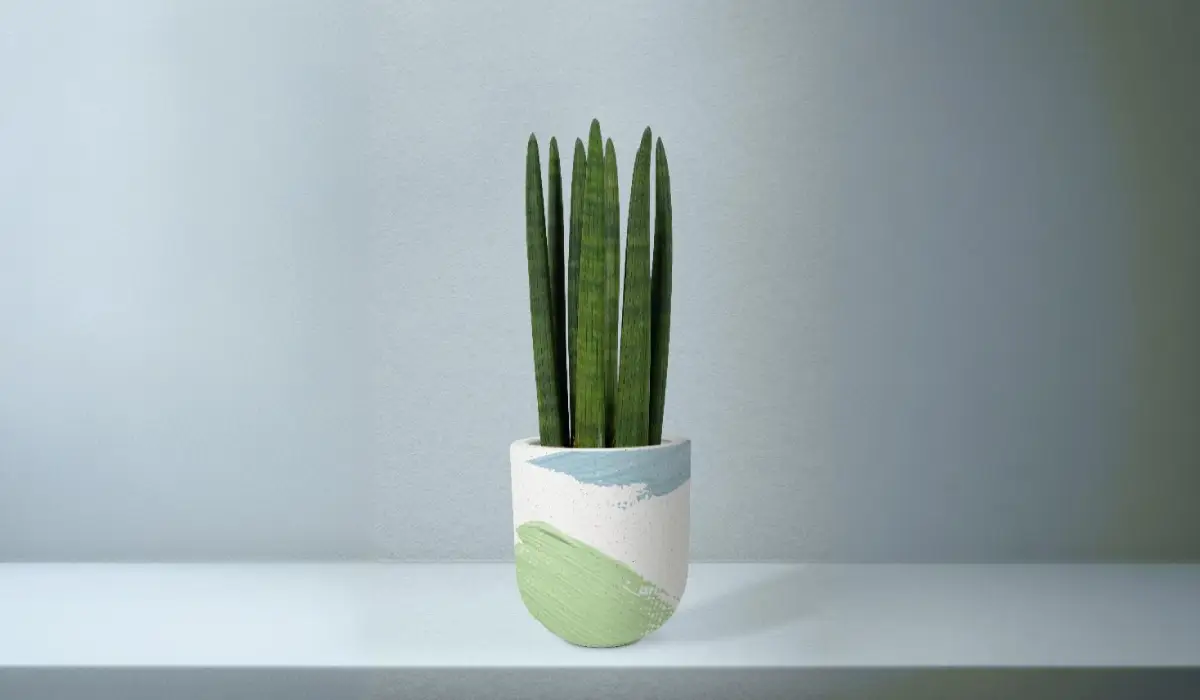
This cultivar features smooth, round leaves that grow vertically, creating a striking architectural presence. The grey-green variegation adds a modern touch, making it an ideal choice for contemporary interiors. Its clean lines and minimalist aesthetic make it a favorite among plant enthusiasts and designers alike.
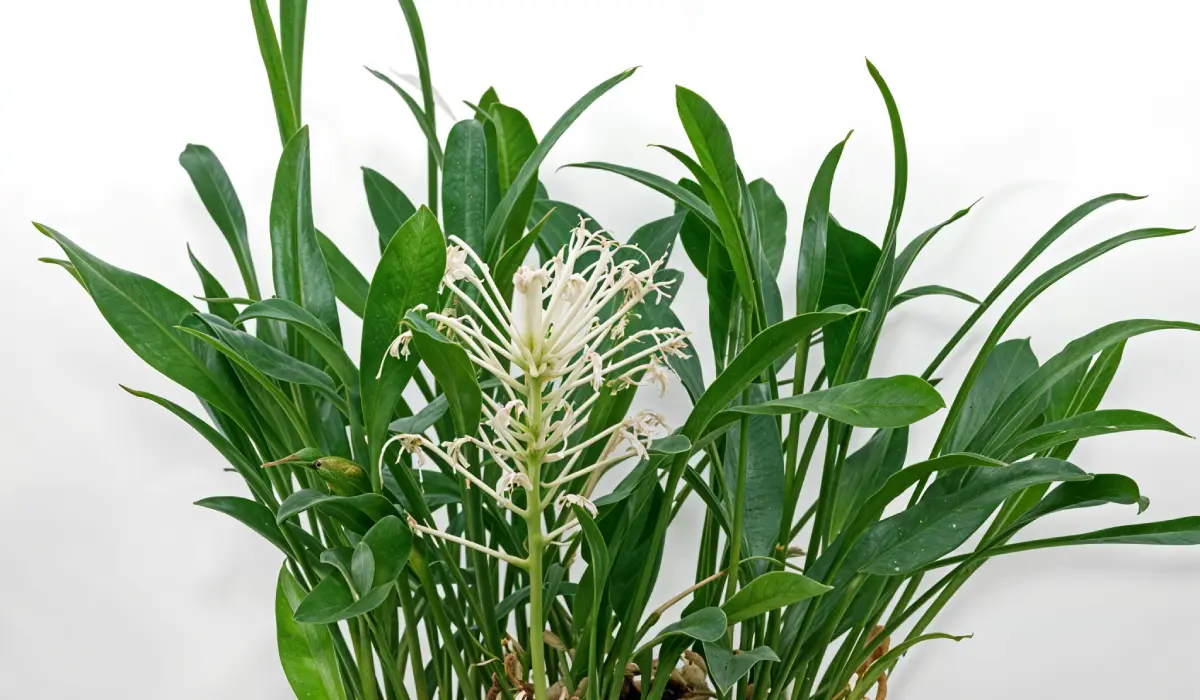
This sansevieria variety is often overshadowed by its more common relatives. Known for its compact size and elegant appearance, this species is perfect for those seeking a low-maintenance yet visually appealing houseplant. Its foliage is not only decorative but also believed to bring positive energy, making it a favorite among plant enthusiasts and feng shui practitioners alike.
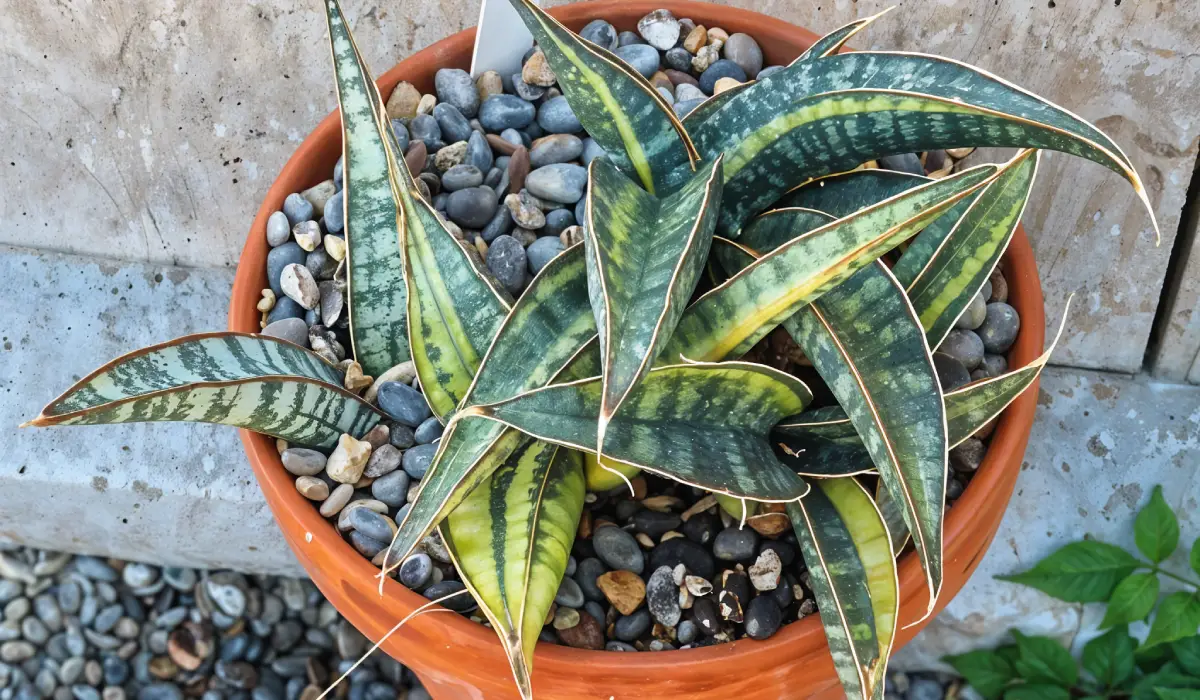
The Sansevieria fischeri is a petite and captivating snake plant variety, perfect for those who love unique textures and subtle beauty. It features deep green stems highlighted by smoky gray banded patterns that maintain their striking look as the leaves mature into a graceful cupped shape. During spring and early summer, it surprises with delicate, lightly scented white flowers that bloom on slender stalks, adding a soft, elegant touch.
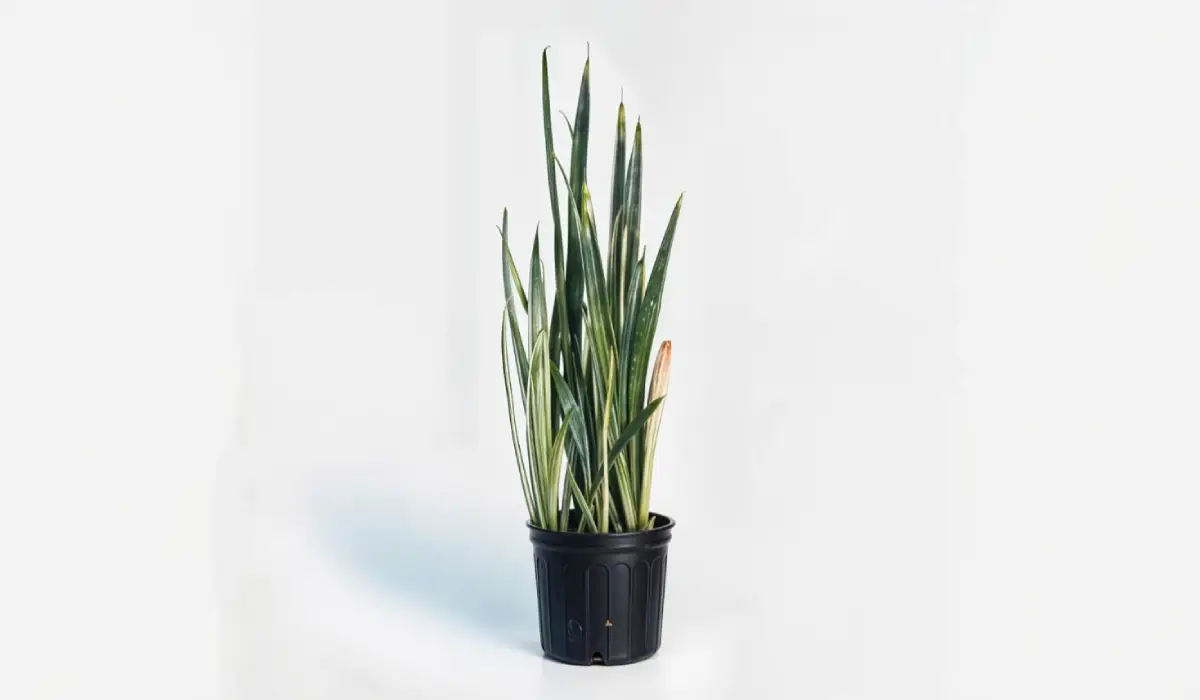
Sometimes called the white snake plant, this award-winning variety adds a sophisticated touch to any indoor space. Its tall, slender foliage not only enhances modern interiors but also brings a refined aesthetic to plant collections.
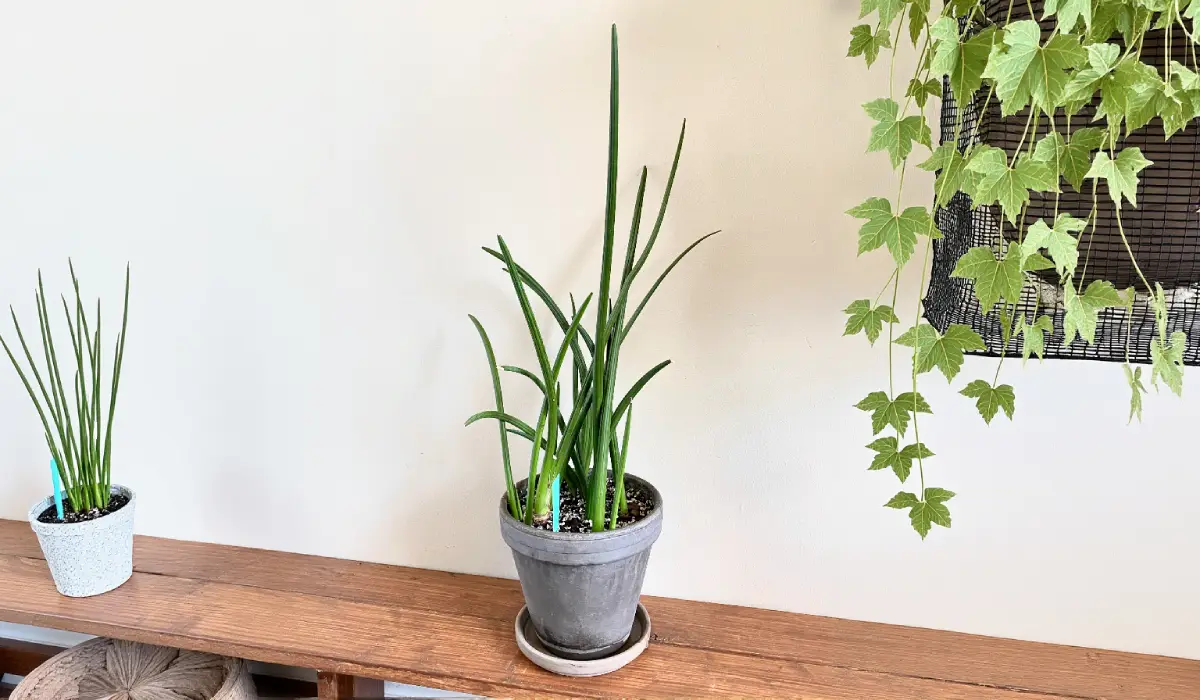
Sansevieria Canaliculata is a rare and fascinating variety native to Madagascar. Unlike the clustering growth habit of Dracaena cylindrica, this species features individual foliage with distinctive grooves on the surface, giving it a unique texture and appearance. It’s best kept indoors during winter to protect it from colder temperatures. For those lucky enough to find one, keep an eye out for its variegated and dwarf varieties, which add even more charm to this already exceptional plant.
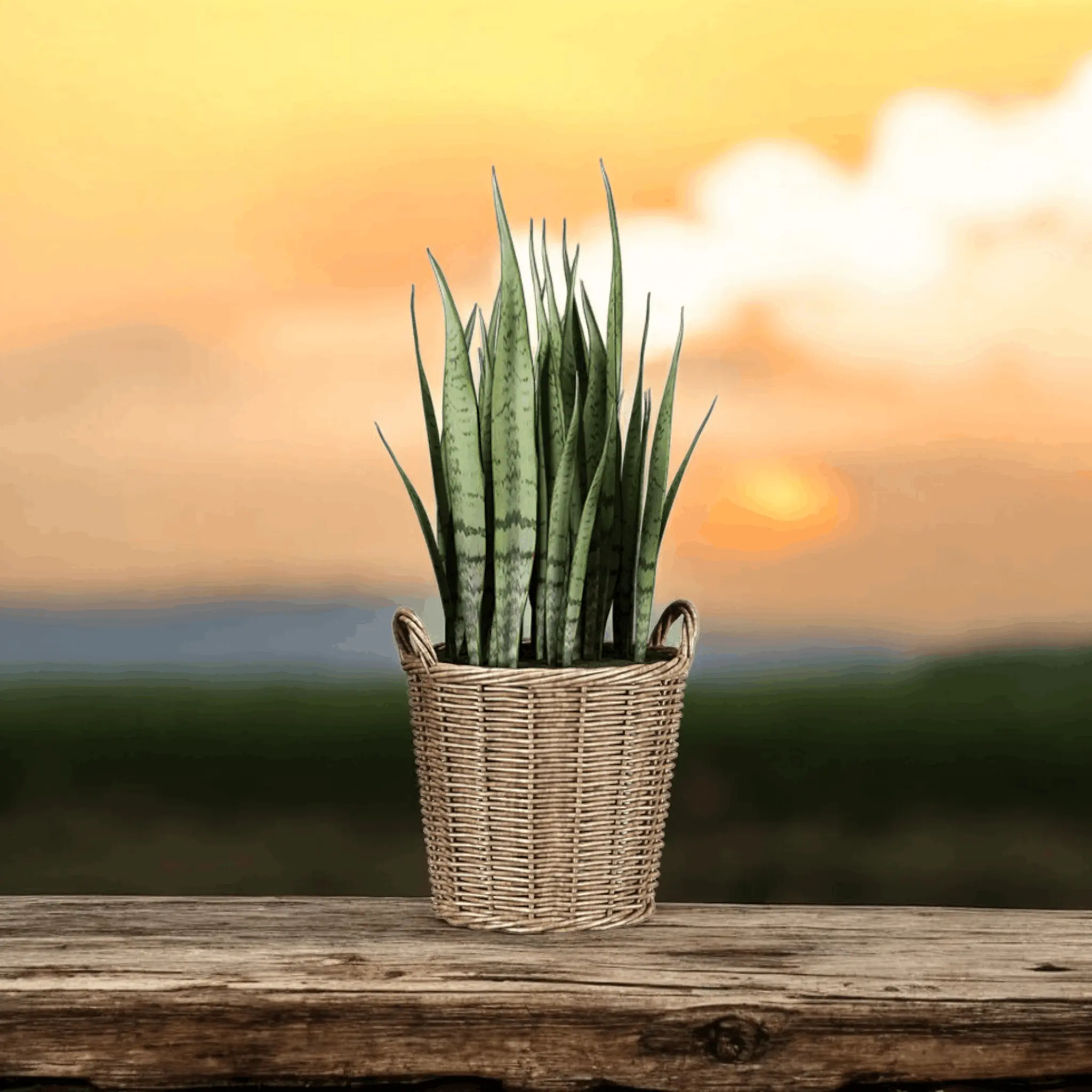
Hailing from Madagascar and Africa, this compact succulent is admired for its sleek, sword-like leaves that feature deep green centers and striking silvery edges. With an average of four to five leaves per plant arranged in a rosette shape, its irregular variegation and snake-skin-like pattern make it a visually intriguing choice. This variety brings a touch of elegance and sophistication to any space.

The Sansevieria francisii is a rare and captivating addition to the diverse types of snake plants. Native to Kenya, this compact herbaceous perennial features upturned, densely packed leaves with striking cross-banding in greyish-green against a dark green background. Its unique growth habit includes elongated stolons that resemble walking legs, adding an intriguing architectural element. While not widely available, this spiky sensation is a must-have for someone seeking something truly distinctive.

Native to the arid regions of eastern Africa, and known for its unique structure, this perennial features stiff, cylindrical leaves that spread outward or stand upright, each marked by a central groove running from the base to about halfway up their length. The leaves, taper to sharp, spine-like tips, adding a bold architectural element to any space. Its rugged, drought-tolerant nature makes it a resilient choice for both indoor and outdoor settings.

The Sansevieria Fernwood, or Sansevieria ‘Fernwood Mikado’, is a striking houseplant that brings a touch of modern elegance to any space. Native to West Africa and part of the Asparagaceae family, this hybrid snake plant is known for its cylindrical, dark green leaves adorned with lighter green stripes, creating a beautiful contrast. Its upright to slightly arching growth habit gives it a sleek, architectural appearance.

Also known as the elephant toothpick, or rhinograss, is a striking succulent that brings a bold architectural presence to any space. Its fan-shaped arrangement of hard, cylindrical leaves, featuring ribbed, spine-tipped foliage in a unique brownish-gray-green hue. The leaves overlap at the base and are marked by shallow longitudinal channels running their entire length. Adding to its allure, the plant produces a tall spike of pinkish-brown to blue-mauve flowers that typically bloom at night
Check out these 45 stunning types of snake plants that showcase the incredible diversity of Sansevieria varieties. While they may all belong to the same family, each one brings its own unique charm and characteristics to the table.
Incorporating these plants into your space requires a bit of care and attention, but the effort is well worth it. If you choose the right variety for your environment and care for it properly, you’ll enjoy not only their beauty but also their air-purifying benefits.
Yes, there are many different types of snake plants, each with distinct characteristics. Some have tall, upright leaves (like Sansevieria trifasciata), while others feature cylindrical or fan-shaped foliage (like Sansevieria cylindrica or Sansevieria pearsonii). They also vary in color, from deep green to silver, yellow, or even variegated patterns. This diversity makes them a favorite among plant enthusiasts.
There are over 70 recognized types of snake plants (Sansevieria), with countless hybrids and cultivars. These varieties range from the popular Dracaena trifasciata (formerly Sansevieria trifasciata) to rare and unique species like Sansevieria masoniana (Whale Fin) or Sansevieria cylindrica (Cylindrical Snake Plant). Each type varies in size, shape, color, and growth habits, making them a versatile choice for indoor and outdoor gardening.
Some of the rarest snake plants varieties include:
Absolutely! Planting different types of snake plants together can create a stunning display of contrasting shapes, sizes, and colors. Since most Sansevieria varieties have similar care requirements—such as well-draining soil, infrequent watering, and tolerance for various light conditions—they can coexist harmoniously in the same pot or garden bed. Just ensure the container is large enough to accommodate their growth.
To identify your snake plant, look at its key features:
Comparing these traits to descriptions or images of Sansevieria varieties can help you determine the specific type.
The “best” type of snake plant depends on your preferences and environment: